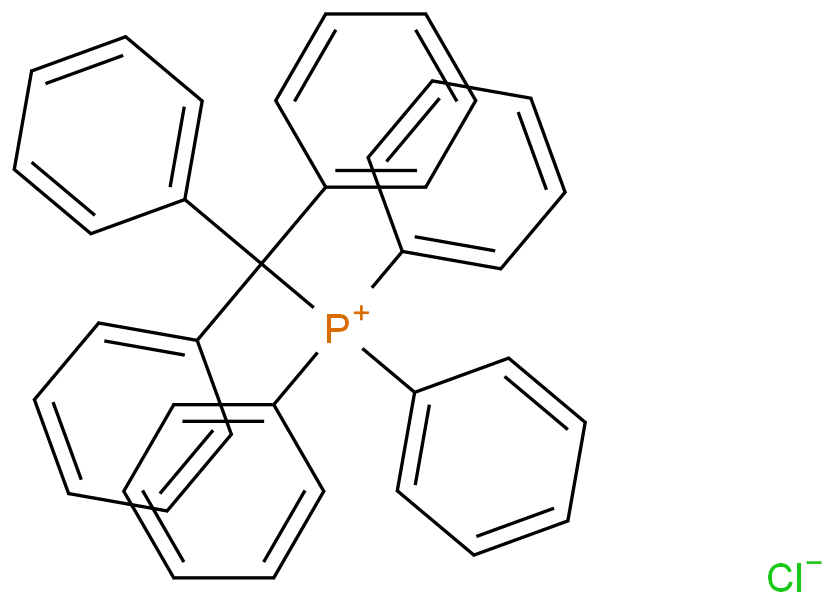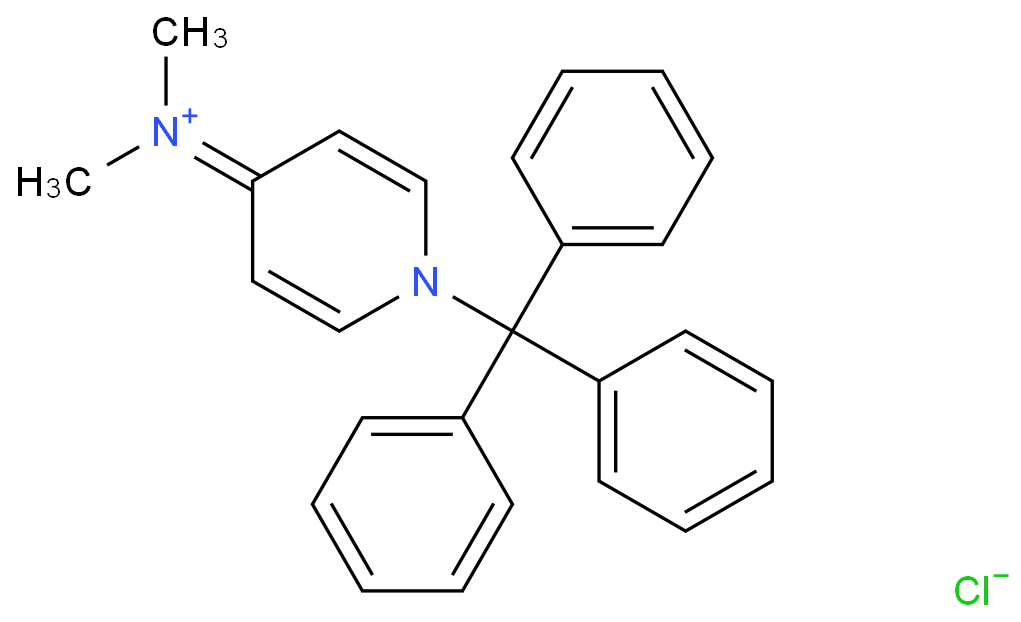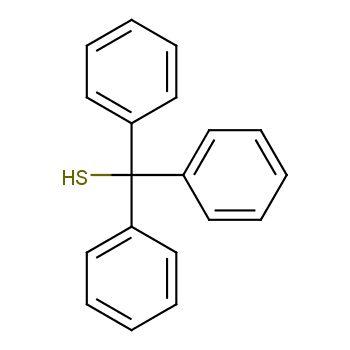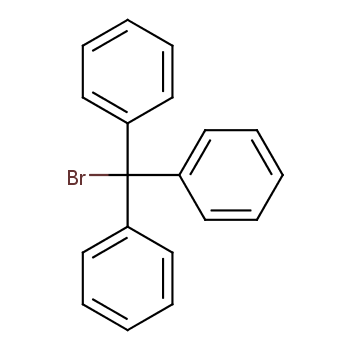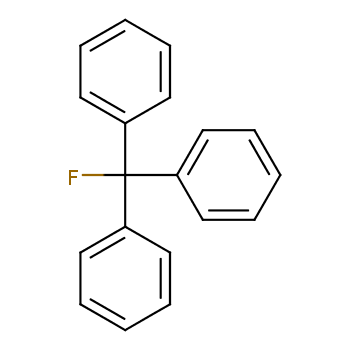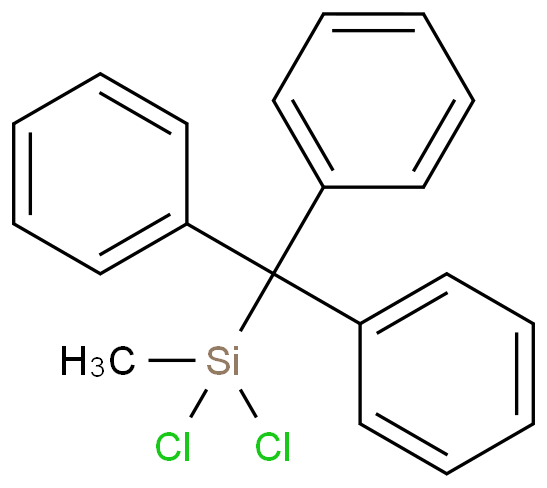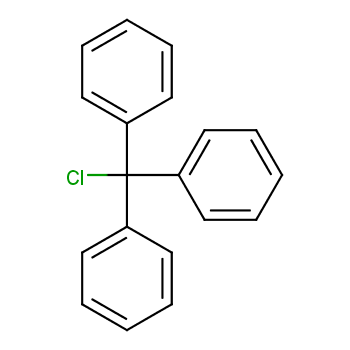 |
TriphenylMethyl chloride
- Iupac Name:[chloro(diphenyl)methyl]benzene
- CAS No.: 76-83-5
- Molecular Weight:278.7754
- Modify Date.: 2022-10-26 20:13
- Introduction: TriphenylMethyl chloride, with the chemical formula C19H15Cl and CAS registry number 76-83-5, is a compound widely used as a protecting group in organic synthesis. This white crystalline solid, also known as Trityl chloride, is notable for its role in safeguarding sensitive functional groups during chemical reactions. Trityl Chloride is used in the preparation of S-trityl-L-cysteine (STLC), a tight-binding inhibitor of Eg5 that prevents mitotic progression. It serves as a key intermediate in the preparation of various organic compounds and is commonly employed in peptide synthesis and other organic transformations. TriphenylMethyl chloride plays a crucial role in organic chemistry, facilitating the synthesis of complex molecules by preventing unwanted reactions at specific sites. Its application extends to pharmaceuticals, agrochemicals, and materials science, where precise control over chemical reactions is essential for product synthesis and development.
View more+
1. Names and Identifiers
- 1.1 Name
- TriphenylMethyl chloride
- 1.2 Synonyms
[Chloro(diphenyl)methyl]benzene [chloro-di(phenyl)methyl]benzene 1,1',1"-(chloromethanetriyl)tribenzene 1,1',1''-(Chloromethanetriyl)tribenzene 1,1’,1’’-(chloromethylidyne)tris-benzen 1,1’,1’’(-Chloromethylidyne)trisben-zene 4-05-00-02497 (Beilstein Handbook Reference) Benzene, 1,1',1''- (chloromethylidyne)tris- BENZENE, 1,1',1''-(CHLOROMETHYLIDYNE)TRIS- chlorotriphenyl-methan CHLOROTRIPHENYLMETHANE EINECS 200-986-4 Methane, chlorotriphenyl- MFCD00000813 TrCl trityl chloride TRT-CL
- View all
- 1.3 CAS No.
- 76-83-5
- 1.4 CID
- 6456
- 1.5 EINECS(EC#)
- 200-986-4
- 1.6 Molecular Formula
- C19H15Cl (isomer)
- 1.7 Inchi
- InChI=1S/C19H15Cl/c20-19(16-10-4-1-5-11-16,17-12-6-2-7-13-17)18-14-8-3-9-15-18/h1-15H
- 1.8 InChIkey
- JBWKIWSBJXDJDT-UHFFFAOYSA-N
- 1.9 Canonical Smiles
- C1=CC=C(C=C1)C(C2=CC=CC=C2)(C3=CC=CC=C3)Cl
- 1.10 Isomers Smiles
- C1=CC=C(C=C1)C(C2=CC=CC=C2)(C3=CC=CC=C3)Cl
2. Properties
- 2.1 Density
- 23220
- 2.1 Melting point
- 110-113℃
- 2.1 Boiling point
- 230-235℃ (20 mmHg)
- 2.1 Refractive index
- 1.5 (20 C)
- 2.1 Flash Point
- 177.9 °C
- 2.1 Precise Quality
- 278.08600
- 2.1 PSA
- 0.00000
- 2.1 logP
- 5.21730
- 2.1 Solubility
- chloroform: 0.1?g/mL, clear
- 2.2 Appearance
- White to yellow solid
- 2.3 Storage
- Moisture Sensitive. Ambient temperatures.
- 2.4 Chemical Properties
- White to yellow solid
- 2.5 Color/Form
- NEEDLES OR PRISMS FROM BENZENE OR PETROLEUM ETHER
- 2.6 Water Solubility
- chloroform: 0.1?g/mL, clear
- 2.7 Spectral Properties
- MAX ABSORPTION (98% SULFURIC ACID): 430 NM (LOG E= 4.58)
SADTLER REFERENCE NUMBER: 4557 (IR, PRISM)
IR: 8336 (Sadtler Research Laboratories IR Grating Collection)
UV: 1259 (Sadtler Research Laboratories Spectral Collection)
NMR: 213 (Sadtler Research Laboratories Spectral Collection)
- 2.8 Stability
- Stable at room temperature in closed containers under normal storage and handling conditions.
- 2.9 StorageTemp
- Store below +30°C.
3. Use and Manufacturing
- 3.1 Purification Methods
- Crystallise trityl chloride from iso-octane. Also crystallise it from 5 parts of pet ether (b 90-100o) and 1 part of acetyl chloride using 1.8g of solvent per g of chloride. Dry it in a desiccator over soda lime and paraffin wax. [Bachman Org Synth Coll Vol III 841 1955, Thomas & Rochow J Am Chem Soc 79 1843 1957, Moisel et al. J Am Chem Soc 108 4706 1986, Beilstein 5 H 750, 5 I 346, 5 II 615, 5 III 2315, 5 IV 2497.] It is moisture sensitive and LACHRYMATORY, TriphenylMethyl chloride Preparation Products And Raw materials Raw materials
- 3.2 Usage
- Trityl Chloride is an alkyl halide commonly used in organic synthesis to introduce the trityl protecting group. Trityl Chloride is used in the preparation of S-trityl-L-cysteine (STLC), a tight-binding inhibitor of Eg5 that prevents mitotic progression.
4. Safety and Handling
- 4.1 Symbol
- GHS05
- 4.1 Hazard Codes
- C
- 4.1 Signal Word
- Danger
- 4.1 Risk Statements
- R14;R34;R50/53
- 4.1 Safety Statements
- S26;S36/37/39;S45;S61
- 4.1 Packing Group
- III
- 4.1 Hazard Class
- 8
- 4.1 Hazard Declaration
- H314
- 4.1 RIDADR
- UN 3261
- 4.1 Caution Statement
- P280-P305 + P351 + P338-P310
- 4.1 WGK Germany
- 3
- 4.1 RTECS
- PA6450000
- 4.1 Safety
-
Hazard Codes:?C,N
Risk Statements: 34-50/53-14-36/37
R34:Causes burns.?
R50/53:Very toxic to aquatic organisms, may cause long-term adverse effects in the aquatic environment.?
R14 :Reacts violently with water.?
R36/37:Irritating to eyes and respiratory system.
Safety Statements: 26-36/37/39-45-61-27
S26: In case of contact with eyes, rinse immediately with plenty of water and seek medical advice.?
S36/37/39:Wear suitable protective clothing, gloves and eye/face protection.?
S45:In case of accident or if you feel unwell, seek medical advice immediately (show the label whenever possible.)?
S61:Avoid release to the environment. Refer to special instructions / safety data sheets.?
S27:Take off immediately all contaminated clothing.
RIDADR: UN 3261 8/PG 3
WGK Germany: 3
RTECS: PA6450000
F: 10-19-21
Hazard Note: Irritant
HazardClass: 8
- View all
- 4.2 Sensitive
- Lachrymatory
- 4.3 Specification
-
? Chlorotriphenylmethane , with CAS number of 76-83-5, can be called [Chloro(diphenyl)methyl]benzene ; 1,1’,1’’-(chloromethylidyne)tris-benzen ; 1,1’,1’’(-Chloromethylidyne)trisben-zene ; chlorotriphenyl-methan ; Methane, chlorotriphenyl- ; alpha-chlorotriphenylmethane ; Benzene, 1,1',1''-(chloromethylidyne)tris- . It is a white solid . Sometimes it is used to introduce the trityl protecting group because it's an alkyl halide.?Chlorotriphenylmethane (CAS NO.76-83-5) can be intermediates to produce drug especially for cephalosporins and be synthesized to idoxuridine for the anti-viral effect.
- 4.4 Toxicity
-
| Organism |
Test Type |
Route |
Reported Dose (Normalized Dose) |
Effect |
Source |
| mouse |
LD50 |
intravenous |
180mg/kg (180mg/kg) |
? |
U.S. Army Armament Research & Development Command, Chemical Systems Laboratory, NIOSH Exchange Chemicals. Vol. NX#04021, |
- View all
5. MSDS
2.Hazard identification
2.1 Classification of the substance or mixture
Skin corrosion, Category 1B
2.2 GHS label elements, including precautionary statements
| Pictogram(s) |  |
| Signal word | Danger |
| Hazard statement(s) | H314 Causes severe skin burns and eye damage |
| Precautionary statement(s) | |
| Prevention | P260 Do not breathe dust/fume/gas/mist/vapours/spray. P264 Wash ... thoroughly after handling. P280 Wear protective gloves/protective clothing/eye protection/face protection. |
| Response | P301+P330+P331 IF SWALLOWED: Rinse mouth. Do NOT induce vomiting. P303+P361+P353 IF ON SKIN (or hair): Take off immediately all contaminated clothing. Rinse skin with water [or shower]. P363 Wash contaminated clothing before reuse. P304+P340 IF INHALED: Remove person to fresh air and keep comfortable for breathing. P310 Immediately call a POISON CENTER/doctor/\u2026 P321 Specific treatment (see ... on this label). P305+P351+P338 IF IN EYES: Rinse cautiously with water for several minutes. Remove contact lenses, if present and easy to do. Continue rinsing. |
| Storage | P405 Store locked up. |
| Disposal | P501 Dispose of contents/container to ... |
2.3 Other hazards which do not result in classification
none
7. Synthesis Route
76-83-5Total: 91 Synthesis Route
8. Other Information
- 8.0 Usage
- Chlorotriphenylmethane is used as laboratory chemical. It acts as a protecting reagent for thiols, alcohols and amines. It is used in organic synthesis for initiating trityl group protection and for preparing S-trityl-L-cysteine (STLC), a inhibitor of Eg5 prevents mitotic progression.
- 8.1 BRN
- 397363
- 8.2 Chemical Properties
- White to yellow solid
- 8.3 Uses
- Trityl Chloride is an alkyl halide commonly used in organic synthesis to introduce the trityl protecting group. Trityl Chloride is used in the preparation of S-trityl-L-cysteine (STLC), a tight-bindin g inhibitor of Eg5 that prevents mitotic progression.
- 8.4 Uses
- amine, alcohol, thiol protecting reagent
- 8.5 Uses
- Efficient method of tritylation of sensitive compounds and their subsequent detritylation
- 8.6 Purification Methods
- Crystallise trityl chloride from iso-octane. Also crystallise it from 5 parts of pet ether (b 90-100o) and 1 part of acetyl chloride using 1.8g of solvent per g of chloride. Dry it in a desiccator over soda lime and paraffin wax. [Bachman Org Synth Coll Vol III 841 1955, Thomas & Rochow J Am Chem Soc 79 1843 1957, Moisel et al. J Am Chem Soc 108 4706 1986, Beilstein 5 H 750, 5 I 346, 5 II 615, 5 III 2315, 5 IV 2497.] It is moisture sensitive and LACHRYMATORY,
9. Computational chemical data
- Molecular Weight: 278.7754g/mol
- Molecular Formula: C19H15Cl
- Compound Is Canonicalized: True
- XLogP3-AA: null
- Exact Mass: 278.0862282
- Monoisotopic Mass: 278.0862282
- Complexity: 235
- Rotatable Bond Count: 3
- Hydrogen Bond Donor Count: 0
- Hydrogen Bond Acceptor Count: 0
- Topological Polar Surface Area: 0
- Heavy Atom Count: 20
- Defined Atom Stereocenter Count: 0
- Undefined Atom Stereocenter Count: 0
- Defined Bond Stereocenter Count: 0
- Undefined Bond Stereocenter Count: 0
- Isotope Atom Count: 0
- Covalently-Bonded Unit Count: 1
- CACTVS Substructure Key Fingerprint: AAADccB4AAAEAAAAAAAAAAAAAAAAAAAAAAAwYMAAAAAAAAABUAAAGAIAAAAADAKAGAAwAIAAAACAAiBCAAACAAAgAAAIiAAAAogIICKBERCAIAAggAAIiAcAgMAOgAAAAAAAAAAAAAAAAAAAAAAAAAAAAA==
10. Question & Answer
-
Introduction Triphenylmethyl chloride, also known as trityl chloride, is a significant compound in the field of organic chemistry. This white-to-off-white crystalline substance has become a cornerston..
-
TriphenylMethyl chloride is a potential genotoxic impurity in the synthesis process of the antihypertensive drug Olmesartan medoxomil. According to the quality guidance principles in the ICH guideline..
-
What is Triphenylmethyl Chloride? Triphenylmethyl chloride, with the chemical formula C19H15Cl, is a colorless to light yellow crystalline solid. It has a melting point range of 93-95°C and a boiling ..
-
TriphenylMethyl chloride is a white solid with a melting point of 111-112°C. It is soluble in most organic solvents and is commonly used in solvents such as dichloromethane, dimethylformamide, and pyr..
11. Recommended Suppliers
-
- Products:chemical supply
- Tel:0571-85083592-85083592
- Email:miranda.liu@tianyechem.cn
-
- Products:Division I, the main production Lead acetate phenylacetamide Cyromazine quality is very good!
- Tel:86-185-31123677
- Email:xing@yan-xi.com
-
- Products:Plastic particles, chemical products
- Tel:00-86-15233218311
- Email:tina@furuntongda.com
-
- Products:API',s intermediates,fine chemicals and plant extracts.
- Tel:86-917-3909592
- Email:gksales1@gk-bio.com
-
- Products:API & Intermediates, Food Addititives,Fine Chemicals. Biochemical & Reagent
- Tel:86-27-59207850
- Email:info@fortunachem.com
12. Realated Product Infomation







